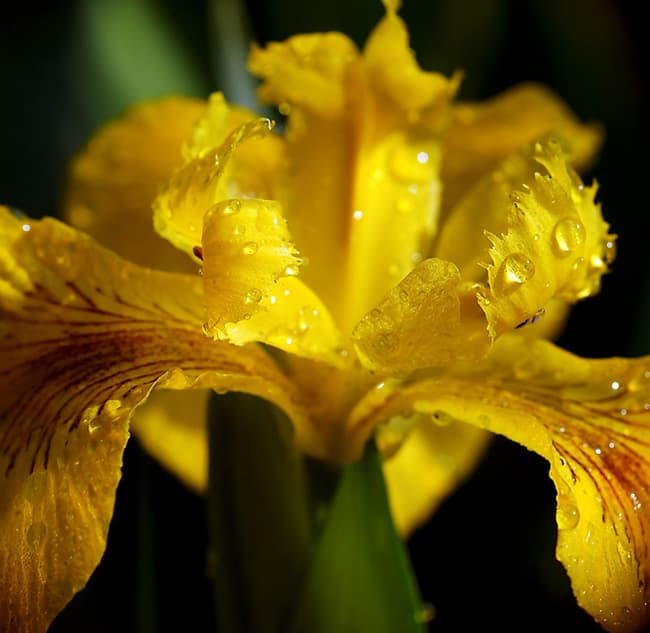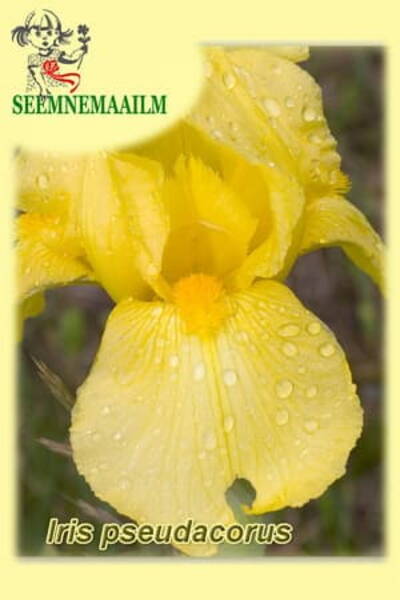Perennial from the Iridaceae family.
Flower colour: yellow-gold.
Natural flowering period: June - July.
Flowering plant height: 100 cm.
Winter hardiness zones: Z3 - Z9.
Use: on the banks of water bodies, suitable for cutting plants.
It is not difficult to grow the Yellow Flag Iris. Its wild forms are easily propagated by autumn sowing of seeds. They should be sown deeper (1.5-2 cm) so that they do not float to the surface of the soil after rain or watering. Cultivated forms (varieties) are easily propagated by parts of the rhizomes bearing buds.
For decorative purposes, the marsh iris, due to its super-powerful development, is best used in park plantings, where its clumps against the background of a lawn or as a frame for large bodies of water make a very good impression. In addition, this iris is the cheapest element of park design, since it can remain in one place for decades without replanting and special care. On humus-rich soils in rainy years, it can develop giant foliage up to 2 m in height. In addition, it is also quite shade-tolerant.
Rhizomes are harvested for medicinal purposes. They are dug up in spring or late autumn, washed thoroughly and dried, after being cut into pieces.
The rhizomes contain tannins, essential oil, isoflavone glycoside, iridine, organic acids (malic, quinic, citric, fumaric, lactic), fatty oil, and starch. The essential oil contains ketone and iron. Yellow iris has an astringent, expectorant, anti-inflammatory, diuretic, hemostatic and anthelmintic effect.
It is part of Zdrenko's collection and is approved as a symptomatic remedy for the treatment of certain malignant tumors, bladder papillomatosis, anacid gastritis, and gastric ulcers.
Root harvesting is usually done in autumn or early spring. For this, two- or three-year-old plants are selected and dug up. The rhizomes are peeled, washed, cut into longitudinal slices and dried under a canopy in the open air, avoiding direct sunlight, in a ventilated attic or in an electric dryer at a temperature of +40 °C. The prepared iris rhizomes are stored in fabric or paper bags for no more than three years.

Yellow Flag Iris.
In folk medicine, a decoction of the plant's rhizomes is used for bronchitis, pneumonia, tonsillitis, intestinal colic, diseases of the spleen, dropsy and pollutions. For diarrhea, ascites, bleeding, goiter and roundworms, fresh juice, powder and tincture of rhizomes in red wine are effective. Tincture of rhizomes in 70% alcohol is used for metrorrhagia.
An aqueous infusion of dried rhizomes is used to treat burns, purulent wounds, ulcers, for rinsing the mouth in chronic and acute gingivitis, toothache. For hemorrhoids, sitz baths with an infusion of fresh iris rhizomes are prescribed. An infusion of rhizomes in sunflower oil is used to rub the skin in case of inflammation of the sciatic nerve, myositis, arthritis.
1. 1 tablespoon of crushed dry rhizomes per 150 ml of boiling water, leave for 2-3 hours, strain. Take 1-2 tablespoons 3 times a day for migraines.
2. Fresh juice from rhizomes 10-15 g per day for periodontal disease.
3. Powder from rhizomes 1-2 g 3 times a day before meals for insomnia.
4. 30 g of dry rhizomes per 200 ml of red wine, leave for 5-7 days in the dark, shaking daily. Take 1 tablespoon every 2 hours for toothache.
5. Tincture on 70% alcohol in a ratio of 1.5:20. Take 2 tablespoons 4-6 times a day for migraines.
6. 1 teaspoon of crushed rhizomes per 1 glass of cold water, leave for 8 hours. Take externally for rinsing, lotions, washing, rubbing.












